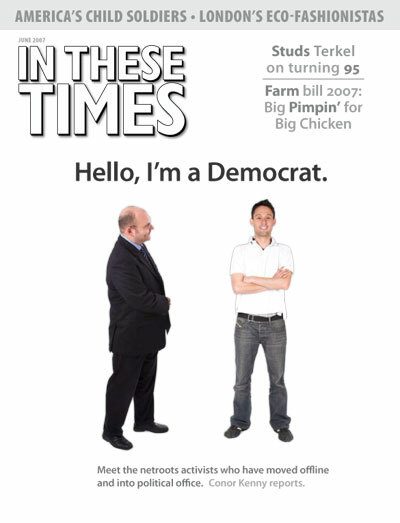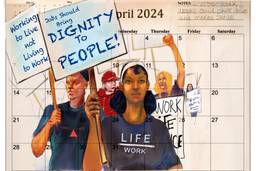Dancing Into the Majority
Once alienated, grassroots activists are finding ways to work with the Democratic Party establishment
Adam Doster

When Michael Heaney served as a special guest to the Brookings Institution’s Governance Studies Program in the fall of 2002, he couldn’t ignore the growing anxiety surrounding the invasion of Iraq. After marching to the White House with a local CodePink chapter and attending larger rallies in D.C. that year, the budding political scientist – now an assistant professor at the University of Florida – took an interest in the makeup of the antiwar movement. “I just started noticing all of the organizational diversity of people there,” he says, “and I got very interested in understanding the differences between these organizations, how they mobilize people, what they wanted and how they framed their arguments.”
This curiosity led him to team up with Indiana University sociologist Fabio Rojas, and together they coined the term “Party in the Street” to describe a “set of individuals and organizations that are both part of a grassroots social movement and that identify and work with a political party.”
Their research, to be published in July in American Politics Research, found that many left-leaning Americans navigate between social movements and the Democratic Party. In surveys distributed at large rallies and conventions in 2004 and 2005, Heaney and Rojas discovered that a plurality of antiwar activists identified as Democrats (40 percent) or articulated some willingness to work with or vote for the party (39 percent). On the other hand, 20 percent of participants identified as members of a third party, which implies that they think organizing under the Democratic tent is counterproductive. From this data, Heaney and Rojas conclude that many social movement activists are beginning to embrace the opportunities the Democratic Party provides in order to achieve their loftier movement goals.
Radio host Laura Flanders, who explores grassroots insurgencies across the country in her new book Blue Grit: True Democrats Take Back Politics from the Politicians (excerpted on page 18), recognizes this phenomenon as well. “Organizations that for years would have defined themselves as movement groups that eschewed electoral politics and never expected to get anything from politicians are deciding to get involved,” she says.
Swelling the ranks
Numerous factors contribute to the recent surge in grassroots political organizing, but popular frustration with the Bush administration is central. Heaney points to “a deep dissatisfaction with the direction of our country, especially with the way President Bush responded to 9/11 and the way that the Iraq war [has gone] and all the mistakes that were made and lies that were told.” The political momentum created by war protesters also helps activate people to fight other injustices perpetuated by Bush and his Republican cohorts, as shown by the immigrant-rights marches held in cities across the country.
But it’s not only anger with Bush that is causing movement-partisan organizations to expand. Lackluster leadership from establishment Democrats, many of whom remain timid on economic and social issues and hawkish on the war, has galvanized disillusioned Democrats and outside activists alike to seek another political path.
“We’ve learned from issue after issue, going back to the Clinton era and earlier, that electing Democrats is just not enough to move our society forward,” says Jeff Cohen, founder of Fairness and Accuracy In Reporting and a media adviser to the Progressive Democrats of America (PDA), a progressive political organization and a grassroots PAC operating inside the Democratic Party. “You need to elect Democrats with backbone and with principles.”
Indeed, more and more progressives who refused to support spineless Democrats and instead backed unsuccessful third-party candidates have come to understand the pragmatic necessity of working within the Democratic Party.
In an electoral system based on winning a plurality of votes, rather than some form of proportional representation, Democrats hold a striking advantage over outside challengers. “In a study of the percentage of Socialist or Social Democratic party members in national legislatures across the world, only South Africa had less – zero – than the two who made it to the [U.S.] House of Representatives a few times in the first quarter of the twentieth century,” G. William Domhoff, a sociologist at the University of California, Santa Cruz, notes on his website. “More leftists were elected to Congress in the ’30s and early ’40s as Democrats … than were ever earlier elected as socialists.” The only way for progressives to beat Democrats, then, is to join them.
PDA’s innovative approach
That’s the goal of PDA, perhaps the national organization that most closely reflects the model posited by Heaney and Rojas. Founded in Roxbury, Mass., during the 2004 Democratic National Convention – primarily by delegates and activists from the campaigns of Howard Dean and Rep. Dennis Kucinich (D-Ohio) – PDA is attempting to carve out a space for progressives in the Democratic Party.
The members of this grassroots association are going about that task using a strategy they call “Inside/Outside,” meaning PDA runs candidates and lobbies members inside the Democratic Party while allying themselves outside the electoral arena with organizations that work to promote its five stated priorities: ending the Iraq war, universal health care, fair and clean elections, economic justice and environmental sustainability.
“I see Inside/Outside as absolutely essential,” says Bill Honigman, PDA’s California state coordinator. “There are going to be times when the party needs to be shook up a little, and the only way to do that is from the outside. By the same token, you can’t do it all from the outside. You have to be involved in the party to change things when it’s going the wrong way.”
Dean’s influence on PDA’s structure is hard to ignore. At the local level, PDA hopes to set up individual chapters in all 435 congressional districts. This tactic is similar to the “50 State Strategy” Dean has employed as DNC chairman, which focuses on organizing Democrats in every voting precinct at all levels of government. So far, PDA National Director Tim Carpenter says that the group has established chapters in 120 districts, which he describes as at least “five folks coming together, pulling papers and meeting at least once a month.” As in all substantial bottom-up organizing, their progress is slow, as evidenced by the dearth of local councils in less populated states like Delaware and Wyoming. But residents elsewhere are expressing great interest. Florida has 13 chapters and California now boasts 23 locals along with close allies in the state assembly’s Progressive Caucus.
PDA also follows the fundraising model of the 2004 Dean campaign, relying almost entirely on sustainer donations that average $22 a month. These local chapters are where the action occurs, allowing PDA to organize in support of congressional actions or in response to lackluster representation. “We’re trying to develop the grassroots so that we build up all of our communities and not just focus on ones that classify as swing districts,” says Honigman.
In many ways, PDA has assumed the role of a party within a party by coordinating collective efforts of like-minded activists while at the same time running or endorsing candidates in certain circumstances. However, unlike the national Democratic Party, the goal is not nominal electoral majorities; PDA aims to transform the party into one dominated by progressive politicians, not corporate interests.
Through its willingness to apply more public forms of pressure like press conferences and teach-ins, PDA has earned national recognition. It was one of the first groups to publicize the infamous Downing Street Memo, which exposed another layer of White House deception in the run-up to the war, and it rallied activists around Ohio’s voting irregularities in 2004. Members also pushed in early 2007 for a congressional debate on a fully funded withdrawal of all troops and military contractors from Iraq.
On the inside, PDA was active this past election season in various Democratic campaigns, including John Hall’s victory in New York’s 19th District. The local PDA chapter raised awareness of John Hall’s progressivism by organizing events throughout northern Westchester County. Hall’s press secretary Tom Staudter later credited PDA with generating vital momentum. While other PDA-endorsed candidates were not as successful, such as Christine Cegelis in Illinois’ 6th District (who lost the Democratic primary by four percentage points to Tammy Duckworth, the favorite of the party establishment), PDA organizers think their local electoral organizing is laying the groundwork for sustainable influence down the road. “Chapters were organized prior to the campaign,” says Carpenter, “they endorsed that candidate and at the end of that race they were stronger and more chapters came out of them.”
Other movement organizing
PDA is not alone in its efforts. A variety of national organizations are simultaneously engaging in electoral work and standard movement organizing.
One prominent group is CodePink, the feminist antiwar group that was founded in 2002. Named with the Department of Homeland Security’s color-coded alert system in mind, CodePink is known for its non-violent direct action campaigns. For example, in November 2002, CodePink members began a four-month vigil in front of the White House to oppose the Iraq invasion and have since repeatedly protested at high-profile political hearings and fundraisers.
But a focus on local organizing and building institutional movements links CodePink with groups like PDA. In four years, CodePink has established more than 250 local chapters, each of which runs autonomous campaigns and actions in their own communities while receiving ideas and assistance from the national unit. These campaigns include lobbying members of Congress and coordinating diplomatic visits, such as a program that sent a delegation of 15 women to Iraq to meet with local women and hear their stories.
“There is this Beltway culture,” says Dana Balicki, CodePink’s media coordinator. “And we are hammering at it to make sure there’s a real element of public discourse.”
Another prime example is the fledging Aurora Project, spearheaded by Bill Fletcher, Jr., founder of the Black Radical Congress and a Belle Zeller Visiting Professor at Brooklyn College, City University of New York. Fletcher looks to Jesse Jackson’s campaigns for president in 1984 and 1988 as models. Jackson and his allies, Fletcher says, promoted “a vision of a non-party political organization that could operate inside and outside the Democratic Party and had a very broad tent within which progressive social movements could find a place but where people of color did not get lost.” Jackson’s coalition took a less democratic shape than originally hoped, but for many of those involved, the potential of the model remains.
Like PDA, Aurora Project organizers hope to build local electoral organizations that are networked nationally. However, unlike many other movement organizations, issues involving race and gender factor prominently into the Aurora Project platform.
“Organizations, given the history of the United States, do not have the option of taking a pass on race if they want to build a majoritarian movement,” says Fletcher. “Attempting to build a bloc that avoids it invariably ends up failing or stumbling at the minimum.” Last December in Washington, D.C., more than 50 experienced activists met to discuss strategy at the Aurora Project’s founding meeting. Organizers are currently traveling around the country talking with local leaders about their plans, which, according to Fletcher, have been met with enthusiasm.
Even MoveOn, an organization whose leadership focuses more on national issue advocacy than organizing the grassroots, has spawned 200 active local chapters through its electoral fieldwork and Internet technology. Similar to PDA, these autonomous groups hold public educational events and participate in national advocacy campaigns while fostering relationships with their congressional representatives, bridging their outside activity with electoral organizing.
“A number of members of Congress have met with our [local councils] because it’s clear that these are some of the people who are influential in the district,” says Eli Pariser, executive director of MoveOn. “It’s very exciting to start to see influences in engaged citizens rather than the local crew of lobbyists.”
The path ahead
The Party in the Street is music to the ears of lefty lawmakers, many of whom now hold key committee and subcommittee chairmanships but have not had an organized, national grassroots arm backing their congressional battles for quite some time.
Relationships between members of the Congressional Progressive Caucus (CPC) and movement-partisan activists are quickly developing and provide mutual benefits. For example, when a legislator proposes a favorable new bill, organizers immediately contact their local representatives to seek out co-sponsors. And the broad networking ability of these groups raises awareness about issues for which progressive legislators are fighting. “I think that when they get their membership to start sending emails, it puts on the radar screen issues that many members might otherwise not be thinking of,” says Sen. Bernie Sanders (I-Vt.), who founded the CPC while a member of the House.
But as Sanders’ insistence on running as an independent suggests, the Party in the Street model presents serious trade-offs for its members. “Their ties to the Democratic Party are both their greatest strength and their greatest weakness,” says Heaney. While aligning closely with Democrats allows for easier recruitment of politically socialized members and access to Washington leadership, groups can grow disconnected from their membership or experience co-optation.
Navigating that liminal space could be the largest obstacle for the Party in the Street’s success. Members of social movements often advocate morally principled but legislatively impractical causes while Democrats seek sound political victories, sometimes undermining justice in the name of compromise. As Heaney notes, people balancing between the movement and the party – which don’t always see eye to eye – are in a precarious position. “There is that force in the party which is trying to pull people out of the social movement and there is a force in the social movement that’s trying to pull people out of the party,” says Heaney. “In a sense, they are not two institutions that go together real easily.”
This fear was dramatized in March when some in the anti-war movement lambasted MoveOn for its actions on the Iraq Accountability Act. Polling its members, MoveOn asked if the organization should back Pelosi’s phased troop withdrawal plan, which was up for a congressional vote. In doing so, they ignored a bill sponsored by Rep. Barbara Lee (D-Calif.), which was never brought to the floor for a vote, but that called for immediate troop withdrawal. Other anti-war groups, such as United for Peace and Justice, and Code-Pink, saw this sole focus on Pelosi’s bill as a compromised one – one that was more in sync with the will of the newly accessible Congressional leadership rather than the country at large.
“There is a danger that you can be so supportive [of Democrats] that you no longer have a balanced view of what’s really happening,” Balicki says. “If you get too far inside the Beltway, you can be sucked right in.”
There’s also a danger of alienating potential allies, especially members of third parties who are skeptical of Democratic partisan motives. “The problem with PDA and MoveOn and others,” says Scott McLarty, media coordinator for the Green Party of the United States, “is that by focusing on the rehabilitation of the Democratic Party, which I think is a hopeless prospect, they don’t allow for the possibility of a new kind of politics.”
But if members of organizations like PDA can master that balancing act, the model could succeed in building a progressive majority in the United States. One unlikely inspiration could be the activists who occupy a similar, albeit more established, organizational space on the right. Groups like the Christian Coalition have cultivated a regimented mass organization focused on local organizing that has successfully pushed their principal issues to the forefront of the GOP agenda while remaining independent of the party. To emulate that success, progressives must remember that Democratic electoral victories are not ends unto themselves; only through a focus on sustained, local mobilization and leadership development can progressives begin to shift away from issues-based pressure groups that have dominated left politics since the ’70’s.
Democratic primaries could provide a natural arena for the Party in the Street to assert its influence. “By putting your maximum program out there and challenging in primaries,” says Domhoff, “you have a chance to reach the general public.”
But as Flanders notes, organizations like PDA must also “work outside of its comfort zone.” It’s a sentiment shared by Fletcher, who notes “a recurring problem in progressive circles, where they come to be dominated by what can best be described as white economic populists. But when it comes to issues of race and gender, there’s a soft peddling in the way of bringing us all together.”
Constructing a broader and stronger progressive tent includes establishing vibrant chapters in communities of color and in historically Republican districts, two constituencies often taken for granted or ignored by national Democrats. Carpenter was enthusiastic about inroads PDA has made in “red districts,” but expressed pessimism about progress in heavily black or Latino locales, something he says PDA is actively addressing through its Diversity Caucus and by assembling a racially diverse executive board.
The kids can’t be ignored, either. As Heaney and Rojas document, the Party in the Street “is composed mainly of the young (18 to 27) and the old (46 to 67), with relatively fewer participants outside these ranges.” Energetic young folks are playing a crucial role organizationally and at the polls, meaning that special attention should be paid to youth recruitment and leadership training.
Perhaps most important, movement-partisans must support and run candidates with bold policy initiatives that will excite an electorate that’s increasingly cynical about government. And intra-party debate should be encouraged. As MoveOn’s Pariser puts it, “A diversity of opinions is a strength.” But only by formulating a strong progressive platform that addresses the concerns of middle- and working-class Americans can movement-partisans avoid political obscurity and shift the Democratic Party to the left.
Groups like PDA cannot yet contend with the influence of more established, corporate-friendly bodies like the Democratic Leadership Council. But if organizers follow the model they have devised and remain open to self-criticism, the Party in the Street might give a lot of progressives reason to dance. “Every great social movement begins in the street,” says Carpenter. “But it ultimately ends in the halls of Congress.”






